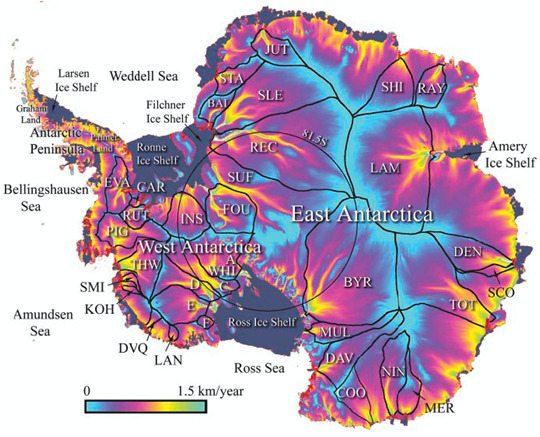
Click figure for larger image.
Glaciers form during the winter season, but persist through the summer with some melt at low altitudes (Figure 1). Snow is deposited in the Accumulation zone, at high altitudes. This new snow is transformed into firn (see Snow Types Section), becoming increasingly dense through subsequent years. As this process continues, until no air pores remain, the glacier is “ice”. This process generally occurs at higher altitudes on a hill-slope environment. As glaciers develop, the upper layers, where new snow is deposited becomes heavy. Gravitational force pulls the upper layers downward, to lower altitudes. As snow is transferred downward, it reaches an Ablation zone, where seasonal melt and transportation of glacier ice occurs. The line delineating the Accumulation zone from the Ablation zone is the Equilibrium Line (Zemp & van Woerden, 2008).
Glacier Mass Balance
The mass balance of a glacier describes the process of production and destruction of glacier material through high altitude snow accumulation and low altitude ice melt (Figure 2). Environmental influences can alter a glacier’s delicate mass balance, fluctuating the glacier’s structure and processes. These large scale process changes can occur within a few seasons or decades. The structural alteration can be in the form of internal ice deformation, frictional surface sliding, ice thickness variance, ice volume change, altitudinal length, advance or retreat. These structural alterations are indicators of regional, and possibly global changes in climate. Specifically, the geographic extent is an early sign of an altering climate regime. Glacier advances can indicate cooling temperatures and increased snow accumulation. While, glacier retreats can indicate warming temperatures and decreased snow accumulation. Glaciers in humid, maritime environments (see Glacier Distribution section) are vulnerable to changes in annual precipitation and seasonal melt. Additionally, glaciers in dry, continental regions are more vulnerable to changes in energy flux and winter snow accumulation (Zemp & van Woerden, 2008).

The following video depicts the first comprehensive, full map of Antarctica's glacier flow movements, generated by NASA. This new research has significant influence on Mass Balance research.
Glacier Flow Movement of Antarctica from NASA Goddard Space Flight Center on YouTube.
References
Glaciers Links
Material on this page was provided by Maren Pauly, Department of Geography, University of Waterloo.
